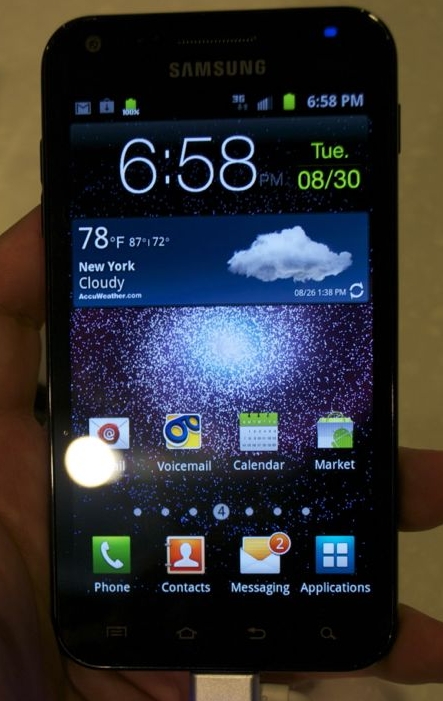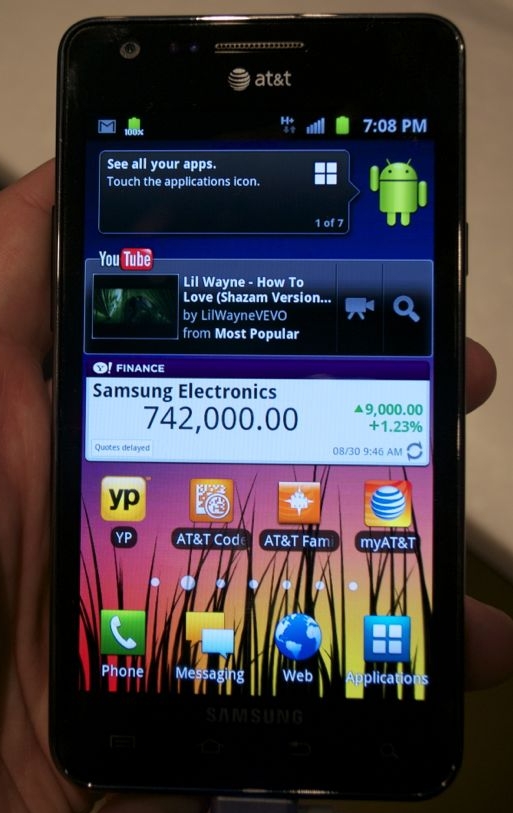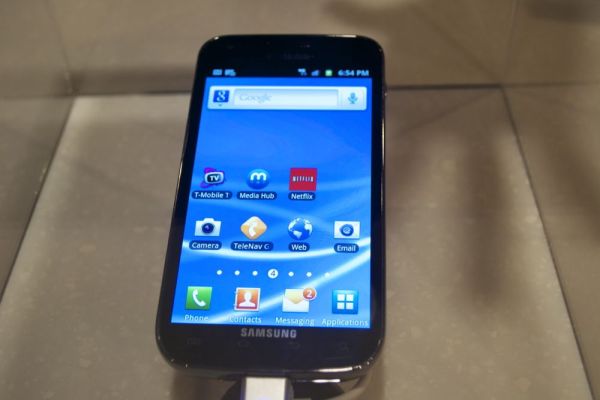Hands on with the US-bound Samsung Galaxy S IIs
by Jason Inofuentes on August 31, 2011 1:37 AM EST- Posted in
- Laptops
- Samsung
- Android 2.3
- Galaxy S II
- Mali 400
- TouchWiz
- Exnos
Samsung has already sold 5 million of them in 85 days in Korea and Europe, but until now the Galaxy S II has been just a dream in a US phone buyers eye. All that was rectified tonight when Samsung announced three Galaxy S II variants that will be entering the US market on Sprint, AT&T and T-Mobile. Brian already ran through the specifications but we thought we'd provide some hands-on impressions from our time with them and a little overview. TouchWiz 4.0 was also showed off, and the skin is comprehensive enough that we'll devote some time in the future to flesh it out. First, a gallery from the event. Apologies for some of the shots, but lining up the best shot in this evironment is impossible.
Sprint Epic 4G Touch

Sprint will be first out of the gates with the Epic 4G Touch, launching on September 16th for $199 on contract. The device is one of two 4.5" slates whose WVGA (800x480) Super AMOLED Plus display is bright and vivid, and surprisingly crisp given the relatively low resolution. There's no denying that pixel density enthusiasts would have been thrilled at 720p or even qHD, but in the hand the only real effect was to make the icons comically large. Horizontal size not withstanding these devices are light and thin, though Sprint's variant is not the thinnest clocking in nearly a millimeter thicker than AT&T's at 9.65 mm. On first grab the lightness gave the impression I was holding a mock-up and not the real thing, but this WiMAX equipped featherweight was smooth and fast in navigating the device's UI. Nenamark was loaded on the device so we ran it through its paces and though the benchmark is not one we regularly feature the device smoothly ran it at 46+FPS. For those thinking of joining The Now Network, this phone will be hard to pass up.
AT&T Samsung Galaxy S II

Ma Bell has foregone alternate naming for their variant, and as the pictures bear out, this is also the closest to the international version that has made the rounds through out Asia and Europe. The 4.3" device lends itself better to the WVGA resolution, and feels noticeably smaller in the hand. Absent in all of these devices is the physical home button so prominent in the international version, but each feels solid in the hand despite a glossy plastic exterior that doesn't feel as premium as the soft touch or metal frames found on recent HTC phones. AT&T's SGSII shares the Exynos SoC and Mali GPU of the Epic 4G Touch and international version so while it is smaller it is no less fast. An NFC radio is on hand, though it was not mentioned at the event it's confirmed by FCC documentation. Release and pricing have not been announced, but we imagine they won't stray far from Sprint's date and pricing. Though it wasn't listed in the specifications released tonight, the phone is rated for HSPA+ at 21.1 Mbps, matching the international version and most likely indicating that both are using the same X-Gold 626 baseband. So, with AT&T's model so closely aping the already shipping internation version, why not be the first out the door? Not sure, but we hope it means it's not long coming.
T-Mobile
T-Mobile is joining Sprint in the 4.5" form factor, though the demo models they had on hand presented rounder corners than Sprint's variant. And that's pretty much all we can say. Samsung and T-Mobile representatives committed to a dual-core processor but would go no further with launch date, pricing or specifications. Indeed, the demo models were kept under glass and not even the representatives were allowed to handle them, except to turn them on periodically so we could appreciate the display. As Brian pointed out in the earlier piece, this could end up being Qualcomm powered, in particular given that a dual core Snapdragon paired with Qualcomm's MDM8220 could make this T-Mo's first DC-HSPA+ 42 Mbps device.
Overview
Since its announcement back at Mobile World Congress in February, the Samsung Galaxy S II has generated a lot of excitement and that excitement has lead to impressive sales figures. This, of course, follows in the success of their first generation Galaxy S devices. But what is it about these phone's that is lighting the world on fire? In a big way, this has to do with Exynos, Samsung's succesor to Hummingbird. The two components of Exynos are a dual-core Cortex A9 clocked at 1.2 GHz and the Mali-400 GPU, both ARM designs. ARM states that clock-for-clock a single-core Cortex-A9 should outperform a Cortex-A8 by about 20%. Give that same A9 a 20% clock bump, and a 40% performance improvement is possible before the second core even comes into the picture. But that only tells us why the Galaxy S II is such a huge improvement over, say, the Nexus S.
What makes the Galaxy S II seem to drastically outpace newer devices like the Droid 3, whose 1 GHz OMAP 4 SoC also features an A9 processor? The special sauce, as Brian will delve into further in his upcoming review of the international Galaxy S II, is Samsung's ability to leverage the Mali-400 to accelerate UI elements and even elements of the browsing experience, as well.
September 16th is fast approaching, so we'll know soon just how well the US variants will perform relative to their international siblings. In the meanwhile, stay tuned for our review and some more Samsung news at the IFA Unpacked event on Thursday.

















36 Comments
View All Comments
JasonInofuentes - Wednesday, August 31, 2011 - link
No need for strong language. I think it's a fair complaint to levy, and I do so as well. Pixel density provides a crisper image which is easier on the eyes and allows more of an image to be shown on the screen, without any scaling. This configuration provides a pixel density of 206 ppi, far off the iPhone's 330+ ppi. But it's also noticeably deficient against the recently popular 4.0" qHD screens we've seen at 275 ppi. And, we know that higher density screens will become the norm sooner, rather than later, with every expectation that this fall we will see 4.x" 720p phones on the market. This is also the trend that we should expect in tablets, and I'm sure that Samsung will not miss this trend and will produce phones to match those specs.This time, however, Samsung chose to highlight the characteristics of their SAMOLED+ screens at a lower, and likely more affordable resolution. Don't think for a minute though that they're not trying to gin up some way of shipping these at full HD.
Thanks for the comments, keep'em coming, but keep'em civil.
Omid.M - Wednesday, August 31, 2011 - link
How do these compare to other popular 4.3" screen phones:Thunderbolt
EVO 4G
EVO 3D
Sensation
Are these variants with the larger (4.5") screens wider than the above models?
@moids
Omid.M - Wednesday, August 31, 2011 - link
Nevermind, just saw the other page that I did not first see.Thunderbolt--2.6"
SGS2 (4.5")--2.7"
They're really pushing it. That's honestly too big to be comfortable, because you will (I will at least) be putting a case on it, too.
I wish a Samsung prod design rep would speak on the decision to go that large in screen size. There's no way they can cite usability research for this. Ridiculous. Makes me lose faith in the Prime, if it's really 4.5" let alone 4.65" ...
JasonInofuentes - Wednesday, August 31, 2011 - link
It's easier to sell big than it is to sell small. The iPhone's tiny little pixels lit the geek world on fire, and even the most laymen iPhone user knows that pictures look real pretty on their small screen. But the density isn't as much a wow factor, particularly when bigger and brighter still sells TVs at Best Buy. Truth be told, I didn't think I could put up with a phone bigger than my OG Droid, I just didn't see the point, till I started using an Incredible and couldn't stand being tied exclusively to the onscreen keyboard. Now, I can't wait to get something bigger, though 4.5"s is too much for my tastes.PenGun - Wednesday, September 7, 2011 - link
A very sweet phone. I've had mine for about a week. One thing not widely highlighted is how amazingly fast it is. Mine has never been anything but fast and responsive. I have never had a hitch or lag. I only wait for networks.kreacher - Friday, September 9, 2011 - link
There have been a few complaints about the Super AMOLED+ display over at XDA forums -1. Its not able to display 16 million colors - banding can be seen on gradients.
2. Low brightness issues - There are discolored bands seen on the notification area and any app with a white / light color background.